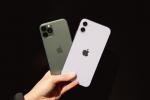Crystal Cox/Business Insider
- Apple's iPhone 11, iPhone 11 Pro, and iPhone 11 Pro Max are launching on September 20.
- All three phones bring noticeable camera upgrades that make it possible to take ultra-wide shots and capture better images in the dark.
- The phones also offer great battery life that can easily last more than a day on a single charge.
- But if you're considering upgrading, it's probably only worth it if you're using an older model like the iPhone 7.
- Visit Business Insider's homepage for more stories.
If you've owned an iPhone from day one — or at least for the last five years or so — you've probably come to expect major leaps in features and performance whenever a new model is announced in September.
After all, the iPhone 5S from 2013 introduced a fingerprint reader to Apple's smartphones, for the first time allowing users to unlock their device without having to peck in their passcode. The iPhone 6 from 2014 heralded a dramatic redesign with a larger screen that came to define how iPhones would look until the iPhone X launched in 2017.
Now, in 2019, I'm here to tell you that the days of expecting major technological advancements that fundamentally change what we can do with our phones every year — or even every two years — may be behind us.
The iPhone 11 and iPhone 11 Pro, which are launching in stores on Friday, share many characteristics with the iPhone XS and XR which Apple introduced last year. They come in the same screen sizes, can recognize your face through Face ID just like the iPhone X phones before it, and have the same notch cutout near the top of the screen for the selfie camera and facial recognition sensors.
Read more: How Apple's new iPhone 11 Pro compares to its biggest rival, Samsung's Galaxy S10
But they also improve on the iPhone in the areas that matter most: namely when it comes to camera quality and battery life. That's as important as ever for Apple, which has been grappling with slowing iPhone sales as smartphone shipments, in general, have been declining.
The iPhone 11 starts at $700, while the iPhone 11 Pro starts at $1,000, and the larger 11 Pro Max will set you back at least $1,100.
Here's a closer look at what it's been like to use the iPhone 11 and iPhone 11 Pro over the last few days.
CameraCrystal Cox/Business InsiderIf you're trying to tell the difference between last year's iPhone and the iPhone 11 or 11 Pro, the camera will be a dead giveaway.
The iPhone is getting a triple-lens camera for the first time with the iPhone 11 Pro and 11 Pro Max, the Pro's larger sibling that comes with a 6.5-inch display. And the less expensive iPhone 11 comes with a dual camera, an important characteristic that distinguishes it from last year's iPhone XR.
All three phones include a 12-megapixel ultra-wide-angle camera with a 120-degree field of view and a 12-megapixel wide-angle lens. That ultra-wide-angle camera makes it possible to capture more of the scene in a single shot — meaning you should no longer have to tell everyone to squeeze in tight to fit in the frame when taking group shots.
This is by no means a feature that's entirely new to smartphones; Samsung's Galaxy S10 and the OnePlus 7 Pro already offer this too.
The Pro model also has a 12-megapixel telephoto lens for achieving a better zoom unlike the iPhone 11. In addition to offering a more sophisticated zoom, you can also switch between this telephoto lens and the wide-angle lens to change the perspective of your portrait mode shots thanks to the Pro model's third lens.
The ultra-wide-angle camera is a useful addition to the iPhone, but it's the iPhone 11's new Night Mode that impressed me the most during my testing. The mode automatically kicks in when you're taking photos in a dark environment, and I've found that shots taken on the iPhone 11 in the dark came out crisper, brighter, and clearer than those taken on the Galaxy S10 or Google Pixel 3a XL. This feature works on all three of Apple's new iPhones.
When shooting in a daytime outdoor setting, the iPhone 11 certainly performed well — but was only marginally better, if at all, than the much less expensive $480 Pixel 3a XL. Both phones took images that were vibrant and sharp with accurate color, outperforming the Galaxy S10's photos which looked overexposed in comparison.
The iPhone's selfie camera is also getting an upgrade from 7-megapixels on last year's model to 12-megapixels on this year's lineup. And selfies taken on the iPhone definitely look great, especially when compared alongside those taken on the Galaxy S10, which once again made colors look too bright and blown out. The Pixel 3a XL gives the iPhone 11 tough competition, but I still felt that the iPhone's image offered more defined details.
Scroll through the images below to see a few sample shots.
iPhone 11 (Bright outdoor shot)Business Insider/Lisa Eadicicco
Google Pixel 3a XL (Bright outdoor shot)Business Insider/Lisa Eadicicco
Samsung Galaxy S10 (Bright outdoor shot)Business Insider/Lisa Eadicicco
iPhone 11 Pro (Low light)Business Insider/Lisa Eadicicco
See the rest of the story at Business Insider
See Also:












